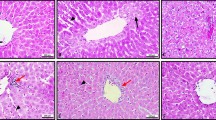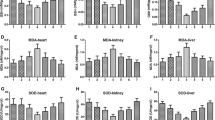Abstract
Alcohol induced oxidative stress is linked to the metabolism of ethanol. In this study it has been observed that administration of ethanol in lower concentration caused gain in body and liver weight. while higher concentration of ethanol caused lesser gain in body and liver weight. Ethanol treatment enhanced lipid peroxidation significantly, depletion in levels of hepatic glutathione and ascorbate, accompanied by a decline in the activities of glutathione peroxidase and glutathione reductase, and increased in hepatic glutathione s-transferase activity. Interestingly catalase activity increases in lower concentration of ethanol exposure, and decreased in higher concentration. Superoxide dismutase activity was also increased on ethanol exposure. But, ethanol feeding did not show any effect on glucose-6-phosphate dehydrogenase activity. Ethanol ingestion perturbs the antioxidant system in a dose and time dependent manner.
Similar content being viewed by others
References
Das, S.K., Nayak, P, and Vasudevan, D.M. (2003) Biochemical markers for alcohol consumption. Ind. J. Clin. Biochem. 18(2), 111–118.
Ishii, H., Kurose, I., and Kato, S. (1997) Pathogenesis of alcoholic liver disease with particular emphasis on oxidative stress. J. Gastroenterol. Hepatol. 12(9–10), S272–282
Fernandez-Checha, J.C., Kaplowitz, N., Colell A., and Gracia-Ruiz, C. (1997) Oxidative stress and alcoholic liver disease. Alcohol Health & Res. World. 21(4), 321–324
Dinu, V. and Zamfir, O. (1991) Oxidative stress in ethanol intoxicated rats. Rev. Roum. Physiol. 28(1–2), 63–67.
Chandra, R., Aneja, R., Rewal, C., Konduri, R., Dass, S.K., and Agarwal, S. (2000) An opium alkaloid-Papaverine ameliorates ethanol-induced hepatotoxicity: diminution of oxidative stress. Ind. J. Clin. Biochem. 15(2), 155–160.
Husain, K., Scott, B.R., Reddy, S.K., and Somani, S.M. (2001) Chronic ethanol and nicotine interaction on rat tissue antioxidant defense system. Alcohol. 25(2), 89–97.
Oh, S.I., Kim, C.I., Chun, H.J., andPark, S.C. (1998) Chronic ethanol consumption affects glutathione status in rat liver. J. Nutr. 128(4), 758–763.
Chatterjee, A.K., Sadhu, U., Dalal, B.B., Chatterjee, T. (1984) Studies on certain drug metabolising enzymes in deoxypyridoxin treated rats. Jap. J. Phamacol. 25, 827.
Lowry, O.H., Rosenbourgh, N.J., Farr, A.L., and Randall, R.J. (1951) Protein measurement with folin phenol reagent. J. Biol. Chem. 193 265–275.
Roe, J.H., and Kuether, C.A. (1943) The determination of ascorbic acid in whole blood and urine through the 2,4-dinitrophenyl hydrazine derivative of dehydro ascorbic acid. J. Biol. Chem. 147, 399–401.
Sinnhuber, R.O., Yu, T.C., and Yu, T.C. (1958) Characterization of the red pigment formed in the thiobarbituric acid determination of oxidative rancidity. Food Res. 23, 626–630.
Ellman, G.L. (1959) The sulphydryl groups. Arch. Biochem. Biophys. 32, 70–77.
Beers, R.F., and Sizer, I.W. (1952) A spectrophotometric method for measuring the breakdown of hydrogen peroxides by catalase. J. Biol. Chem. 195, 133–140.
Goldberg, M.D., and Spooner, J.R. (1983) Glutathione reductase. In: Methods Enzyme Analysis. Eds. Bergmayer, H.U., Bergmayer, J. and Grabi, M. Academic Press, Inc., Florida,: Vol.III, 3nd edn. pp., 258–265.
Habig, W.H., Pabst, M.J., and Jakoby, W.B. (1974) Glutathione S-transferase, the first enzymatic step in mercapturic acid formation. J. Biol. Chem. 249, 7130–7139.
Paglia, D.E., and Valentine, W.N. (1967) Studies on the quantitative and qualitative characterisation of erythrocyte glutathione peroxides. J. Lab. Clin. Med. 70, 158–159.
Marklund, S., and Marklund, G. (1974) Involvement of superoxide radical in the auto oxidation pyrogallol and a convenient assay for superoxide dismutase. Eur. J. Biochem. 47, 469–474.
Beutler, E. (1988) Glucose-6-phosphate dehydrogenas—New perspectives. Blood. 73, 1397.
Husain, K., and Somani, S.M. (1997) Interaction of exercise training and chronic ethanol ingestion on hepatic and plasma antioxidant system in rat. J. Appl. Toxicol. 17(3), 189–194.
McCord, J.M. (1979) Superoxide dismutase In: Isozyme: Current topics in biological and medica research. Eds. Tattazzi, M.C., Scanalios, J.G., Whitt, G.S. and Alan, R., Liss Inc. New York, section 1.
Marklund, S. (1984) Properties of extracellular superoxide dismutase from human lung. Biochem. J. 220, 269–272.
Fridovich, I. (1999) Superoxide dismutases. J. Biol. Chem. 264, 7761–7764.
Koch, O., Farre, S., DeLeo, M.E., Palozza, P., Palazzotti, B., Borrelo, S., Palombini, G., Cravero, A., and Galeotti, T. (2000) Regulation of manganese superoxide dismutase (MnSOD) in chronic experimental alcoholism: effects of vitamin E-supplemented and-deficient diets. Alcohol Alcohol. 35(2), 159–163.
Aniya, Y., and Daido, A. (1994) Activation of microsomal glutathione S-transferase in tert-butyl hydroperoxide-induced oxidative stress of isolated rat liver Jpn. J. Phamacol. 66(1), 123–130.
Author information
Authors and Affiliations
Corresponding author
Rights and permissions
About this article
Cite this article
Das, S.K., Vasudevan, D.M. Effect of ethanol on liver antioxidant defense systems: Adose dependent study. Indian J Clin Biochem 20, 80–84 (2005). https://doi.org/10.1007/BF02893047
Issue Date:
DOI: https://doi.org/10.1007/BF02893047




